mNo edit summary |
|||
| Line 1: | Line 1: | ||
{{TOCright}} | |||
==Abstract== | ==Abstract== | ||
<center>''This page narrates a project implemented by Team Terrific between May and July of 2014 for the Practivistas Dominicana program in Santo Domingo, Dominican Republic. The project includes working with a new community in Arroyo Norte to develop prototypes that will eventually be chosen by community members to be used in a new sustainable market, consisting of 25 rooms, made mostly of waste materials from the local dump site.''</center> | <center>''This page narrates a project implemented by Team Terrific between May and July of 2014 for the Practivistas Dominicana program in Santo Domingo, Dominican Republic. The project includes working with a new community in Arroyo Norte to develop prototypes that will eventually be chosen by community members to be used in a new sustainable market, consisting of 25 rooms, made mostly of waste materials from the local dump site.''</center> | ||
Revision as of 23:28, 13 June 2014
Abstract
Background
The newest project site for the Practivistas Dominicana program is in Arroyo Norte. Arroyo Norte is a sustainable community, which was built in close proximity to the dumpsite for Santo Domingo. The dumpsite is the largest in the country, and the community exemplifies Appropriate Technology by building homes, community centers, and markets out of the materials they have in abundance at the nearby dumpsite. They have asked for us to come in and use the waste materials to build prototypes for furniture and walls to construct a new supermercado in Arroyo Norte, the first large market in the community. The market will be built in the near future, but for this project, we will only be experimenting with materials to develop alternative designs for things necessary in a marketplace. The 25 room supermercado will need a funding source, which our prototypes will hope to generate upon completion. Our role in this project with the community members of Arroyo Norte is to make a good impression on them as the first Practivistas group to work with them, and also to develop aesthetically pleasing, structurally sound, and economically feasible prototypes for use in the supermercado.
Problem Statement
The objective of this project is to research and develop wall and table prototypes that can be reproduced and used in a sustainably constructed market in Arroyo Norte, Dominican Republic.
Criteria
The following table of criteria was developed in a community meeting and is used to evaluate alternative solutions.
| Criteria | Constraints | Weights |
|---|---|---|
| Resistance | Prototypes must successfully pass the spray test, scratch test, and tensile strength test. | 10 |
| Marketability | The prototypes must have potential for reproduction at minimum, and potential for revenue production at best. | 9 |
| Aesthetics | The prototypes must be visually acceptable to the community members involved, and look clean. | 9 |
| Security | The wall prototypes must look secure and be resistant to break-ins. | 9 |
| Educational Value | The prototypes must display reused materials in some way. | 9 |
| Accessibility of Materials | At least 90% of materials used in the prototypes must come from the Arroyo Norte waste station. | 9 |
| Mobility | The furniture must be movable by 2 or less people. | 8 |
| Adaptability | The prototypes shall be created with room adaptability in mind. | 7 |
| Cost | The prototypes should minimize cost where possible. The walls shall not exceed $100 USD each, and the tables shall not exceed $50 USD each. | 6 |
Literature Review
This section is based on research of the most up-to-date information relevant to the Arroyo Norte sustainable market materials project. Most of the information outlined below is pulled from credible sources and project pages of successfully implemented projects or processes to upcycle materials from the waste stream. Upcycling is done by processing previously used materials that would otherwise go to the waste stream, and creating something new that is better aesthetically or more purposeful than the original material(s).[1]
Santo Domingo Waste Stream Study
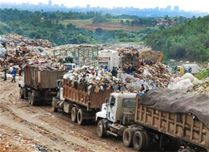
Santo Domingo creates a total of 11,000 pounds of trash daily. Its population density, nearly 4 million Dominican citizens and 2.5 million tourists annually, is the major contributing factor. The largest landfill in the country, Duquesa, is located in Arroyo Norte. All of the waste at Duguesa is managed by the ADN National District Municipality. According to the an interview with Max Da Silva, manager of operations in Duquesa, by DiarioLibre, there are around 400 trips by grabage trucks a day during the operation times which are from 6:00 am to 8:00 p.m.[2] Management of this waste is too much for the municipality to handle and a disproportionate financial burden(as much as 300 pesos a month according to local accounts) on the citizens of Santo Domingo. Waste pickup is often sporadic due to poorly maintained equipment. There are programs however to combat the waste management issues, including alternative energy projects, non-profit organizations such as trashmountain, and recycling implementation (2009).
Common Upcycled Waste Stream Materials
The most common materials re-used from the waste stream include plastics, metals, and paper. For the scope of this project, we will examine all materials present in the waste stream that have potential to be re-used or up-cycled into indoor furniture for a marketplace in Arroyo Norte.
Plastic
Plastic is a petroleum-based material that can be manufactured in various sizes, shapes and strengths. Each type of plastic that is produced usually has the chemical formula, or Plastic codes, identified somewhere on the product in the form of a number, surrounded by a recyclable sign. Each of these material signatures helps the end user to sort the plastics accordingly and identify which materials can be used again.
| Image | Description | Melting Temperature |
|---|---|---|
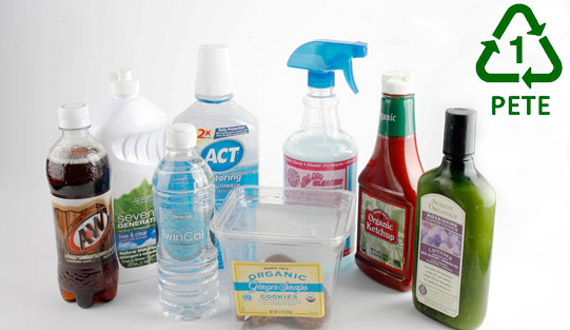
|
PETE #1: Polyethylene Terephthalate (PET) can be found in the form of plastic bottles that contain liquid like water or soda, and also peanut butter containers. | 540 degrees F [4] |
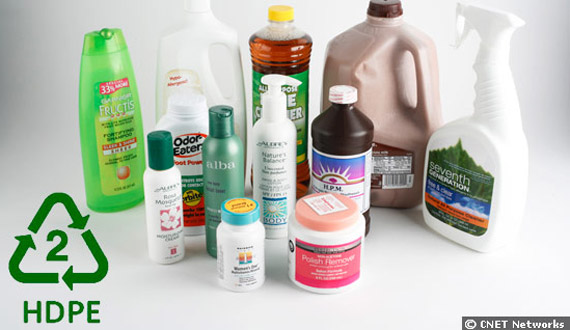
|
HDPE #2: High Density Polyethylene is mostly found in the waste stream in the form of soda caps, milk jugs, but is also used to create juice bottles and some trash bags.[3] | 400 degrees F [4] |
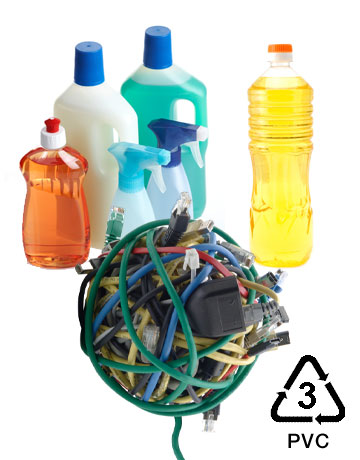
|
PVC #3: Polyvinyl Chloride is a type of plastic used for PVC piping, juice bottles or cling wrap.[3] | 325-350 degrees F [4] |
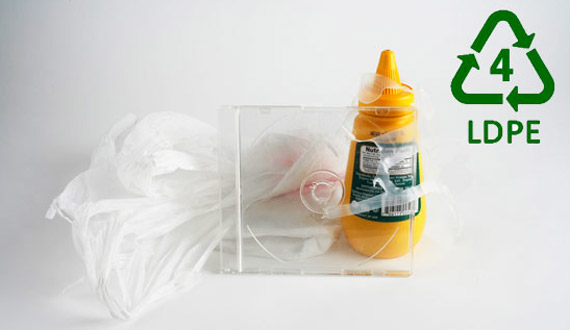
|
LDPE #4: Low Density Polyethylene is used for flexible items such as ziplock freezer bags, squeezable condiment bottles, and flexible lids.[3]The softening point for this type of plastic is 248 degrees F. [5] | 284 degrees F [4] |
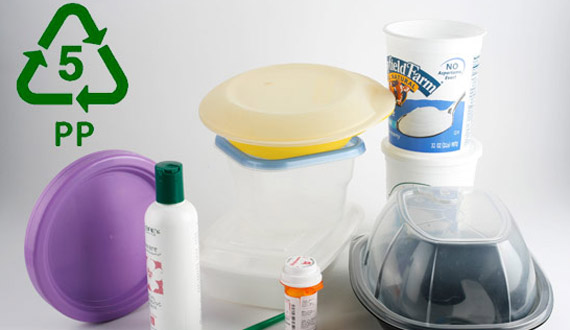
|
PP #5: Polypropylene is used to make many single-use cups, lids, and yogurt containers.[3] This material has the strength to withstand high heat and stress. | 575 degrees F [4] |
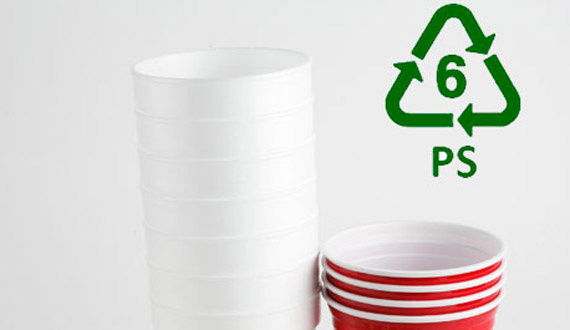
|
PS #6: Polystyrene can be used for things such as packing peanuts, egg cartons, disposable cutlery and disposable food containers.[3] | 350-390 degrees F [4] |
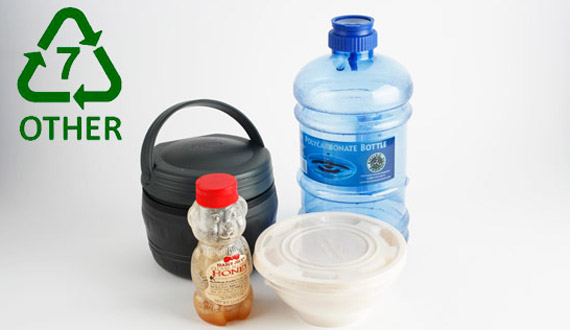
|
Other #7: Other plastics refer to polycarbonate or ABS usually, and are used to case electronic equipment, and sometimes are used to make to-go containers.[3] | (ABS): 400-420 degrees F [4] |
Melting Plastics Vs. Burning Plastics
The process of melting and reshaping plastics is more safely implemented when the plastic reaches a high enough temperature to melt the plastic, but a low enough temperature to never burn the plastic. Health hazards are associated with burning plastics because once the material reaches a high enough temperature to off-gas, toxic chemicals are released into the atmosphere, unique to each type of plastic. Dioxins are the most potent carcinogen when tested on animals, and are present in halogenated plastics, such as PVC and plastics containing chlorine and fluorine. When these halogenated plastics are burned, dioxins pose the highest threat to human health. [6]
Rubber
Tires will be the most applicable form of rubber to be used in the creation of furniture for the marketplace. Another application of rubber is to find bicycle tire tubes or any rubber tubing of the like, and weave them together to create a seat for a chair.
Metals
Metals enter the waste stream in many types, forms, and conditions. The most common metals that will be examined for this project are tin cans, aluminum cans, and electronic waste. Although many other materials enter the waste stream that can be used to make furniture in Santo Domingo, Dominican Republic, these materials seem to be the most readily available to every one, and can be repurposed in any home before entering the waste stream.
Tin
Tin enters the waste stream in the form of tin cans, mostly intended to store food. Tin cans are a widely distributed material, and are an excellent choice for upcycling because the material is 100% recyclable and is a non-renewable resource. [7]
- Melting point: 449.4 degrees F [8]
Steel
Steel is most commonly found in the waste stream in the form of steel cans. Throughout history, steel cans have been manufactured with different materials to eliminate corrosion of the steel and toxicity of the materials entering the food contained within the cans.
Tin-coated cans are manufactured by coating the steel can with tin on both sides of the metal before forming the cans. The tin acts as an anti-corrosive material, but acidic foods can cause the tin to corrode, leaching tin into the food and causing gastrointestinal distress. Tin-coated cans are still manufactured today, but are an expensive option so are not used as often as some other anti-corrosion methods. [9]
Tin-free cans are made of tin-free steel, which is coated with a material (originally chromium metal and chromium oxide) to prevent rusting. Although this process is cheaper than tin-coated cans, it is not as effective in preventing corrosion, and these products are more difficult to weld. [9]
Bi-metal cans are made by mixing two different types of metals together. The main body of these type of cans are made of steel, and the top or bottom of the can is made up of another metal, usually aluminum. These cans are difficult to recycle because unlike tin-coated cans, these are not alloy metals (an even mixture of two metals). For this reason, these cans should not be melted down. [9]
- Melting Point of steel: 2600-2800 degrees F [8]
Aluminum
Aluminum cans, like those used to store soda and other single-serving beverages are very commonly found in the waste stream. These cans be be used in a variety of ways, especially by crushing, cutting, and melting them to create larger objects, such as chairs or dividing walls.
- Melting Point: 1220 degrees F [8]
E-Waste
Electronic waste includes computer-chips, motherboards, wires, and sometimes contains precious metals that can be used in the marketplace for purely decorative purposes.
Tree Products
The most relevant tree products that enter the waste stream for this project are wood and cardboard. Wood products will be available in a variety of forms, conditions, shapes and sizes. The most adaptable transformations of waste wood will be complete shelf pieces or clean scrap wood that can be chopped into chips, and molded with glue to create a home-made particle board-type material. Cardboard materials found in the waste stream could be adapted to create end-tables or chairs. In order to do this, the cardboard would need to be relatively clean to begin with. After collecting pieces of cardboard, they can be glued together to create a 3-D cube, which can be pre-cut to shape before the gluing process or can be cut to shape after the glue dries to create customized shapes or designs.
Examples of Successful Upcycled Projects
There are already hundreds of upcylced examples on the internet already. Here are some projects we found that can be used as inspiration to build items that may be needed in a super market.
Metals
| Project | Relation | Item Type |
|---|---|---|
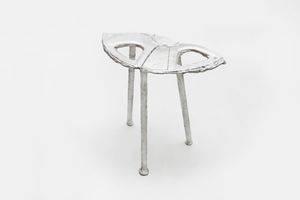 |
Can City is a project in Brazil where the trash collectors capture tin cans from the waste stream and re-purpose them. The collected tin cans are melted down and turned into a disc of solid tin. From there, the tin is transformed into furniture like chairs and tables. With this technique we could use tin cans for virtually anything. [10] | Wall/Table/Shelf |
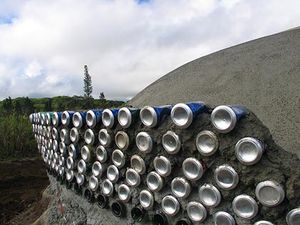 |
In this picture cans are shown making a wall with a certain mixture. These cans can be used with cement or something similar to build a wall for the market, making thin, sturdy walls with a low cost. [11] | Wall |
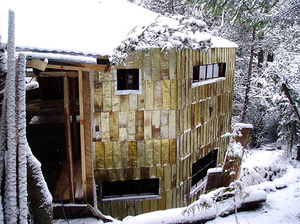 |
This house is made out used soup cans that are rolled, flattened, and patched together to make a wall. Not only is this easy to replicate, the shine from the cans also makes it useful in reflecting heat and aesthetically pleasing. The soup cans are also thin enough to work as aisles as well. [12] | Wall |
Woodlike Materials
| Project | Relation | Item Type |
|---|---|---|
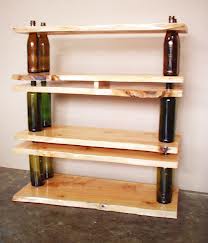 |
In this project old glass bottles and scrap wood were used to make a shelf. By cutting holes and using the same sized bottles, the bottles were able to serve as a sturdy shelving system. Because of the abundance of plastic and glass bottles in Arroyo Norte, these shelves would serve as a perfect model for a similar structure that could be used with our available materials inside of the super market. [13] | Shelf |
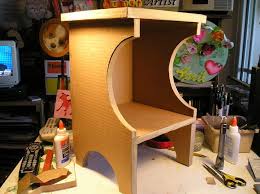 |
This bedside table is made out of cardboard and glue. After designing the table and cutting out the pieces accordingly, the cardboard was layered together for extra strength. With this in mind, a table of any shape can be made using the same process, big or small. Tables like these can be used to make shelfs, food stands, and other types of furniture needed in a market. [14] | Table |
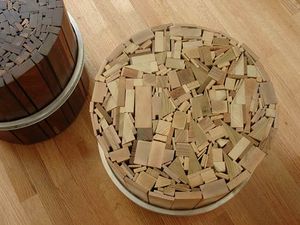 |
This stool appears to be made of glued together wood chips. Though it's just a stool, it gives us a starting point for what can be turned into a lot of things. Multiple stools can be stacked to make a table or a stand, or a bigger mold can even be used. This stool is a model because since it uses wood chips, we won't have to look for whole pieces of wood that would normally be used for tables or shelves. | Table/Stand/Shelf |
Other Sources
Plastics
| Project | Relation | Item Type |
|---|---|---|
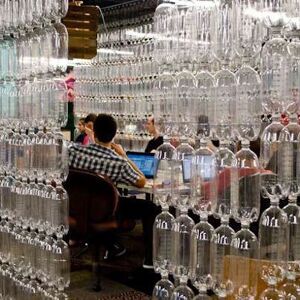 |
These bottles are strung together with fish line to make a dividing wall out of plastic bottles. In a supermarket, these can be used to divide sections of a store and even different aisles of food. Because there are so many plastic bottles that are used in this city, this idea is practical and easy to replicate. [15] | Walls |
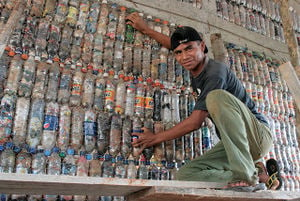 |
This wall was created using plastic bottles, filled with a dry clay material, and lined up in a clean fashion, with chicken-wire fence holding it together.[16] | Walls |
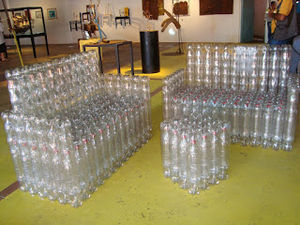 |
These sofas made out of plastic bottles are a practical idea for a super market. There is a surplus of plastic bottles which can be used in this sense to make chairs or even stands for food. Because they are so tightly bound, they are capable of holding a lot of weight. [17] | Tables/Stands |
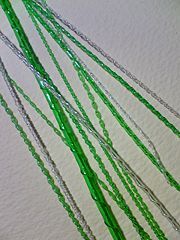 |
After cutting plastic bottles into spiraled strips, they were heated at their specific temperatures, and curled to make plastic wire-like strips. These wires could be useful in many different ways. They can be used to string together the aforementioned plastic bottle walls, or can be woven together to make a basket for produce, etc. With so much plastic, the possibilities are endless. [18] | Wire |
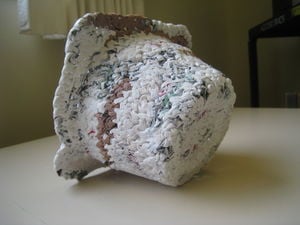 |
This FBP Hot Dang Plastic Encasement plastic experiment was created using HDPE plastic bags, first cutting them into strips,and knotting them together into a continuous string of plastic. Then, the plastic bag string was used to crochet a bowl together. Once the bowl was created, the bowl was placed into a 350 degree F heated ceramic bowl to fuse the bottom, and the top was fused together with an iron set to 350 degrees F also. Once cooled, the material is rigid plastic, with a fun design. [19] | Table top |
n
Cement Alternatives
Al-Manaseer and Dalal (1997) conducted a study to determine how much the concrete density can be reduced by mixing recycled plastics into the concrete mixes. The pieces of post-consumer plastic used in the mixtures were no larger than 13 mm. The study concluded that the density of the concrete was reduced by adding plastic to the mixture. In fact, the density of the concrete was reduced by 2.5%, 6%, and 13% for concrete mixtures containing 10%, 30%, and 50% plastic aggregates, respectively. 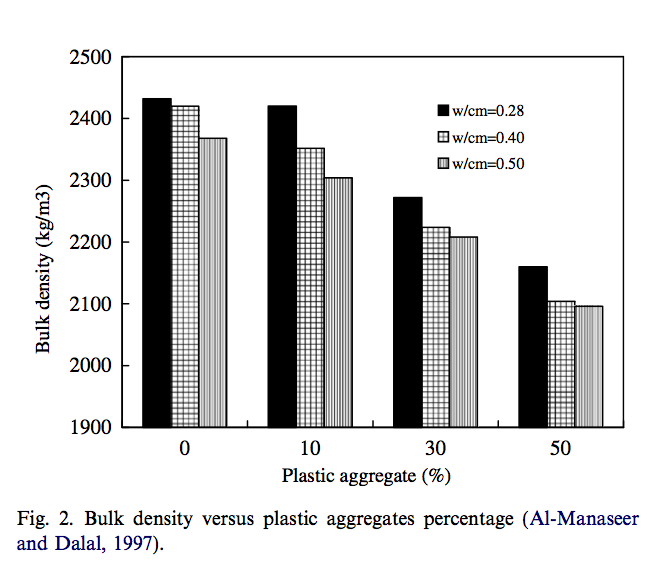 [5]
[5]
Furthermore, Bayasi and Zeng (1993) concluded that the addition of polypropylene fibers fibrillated to less than 19mm had nearly on the compressive strength of concrete, but they did enhance the toughness of concrete under pressure and increased the energy absorption of the material. [5]
Construction
Timeline
Costs
The table below describes the materials list for the first week
| Material | Cost (DR $) | Amount | Total Cost |
|---|---|---|---|
| Wood Palletes | 150 | 2 | 300 |
| Oil bins | 300 | 2 | 600 |
| Wood chips (sack) | 100 | 2 | 200 |
| Plastic # 2 (sack) | 100 | 2 | 300 |
| Transportation | 500 | 1 | 500 |
Operation
Maintenance
Schedule
Instructions
Conclusion
Testing Results
Discussion
Lessons Learned
Next Steps
Troubleshooting
Team
References
- ↑ http://dictionary.reference.com/browse/upcycling
- ↑ Nikaury Arias (April, 2008) "Duquesa Recibe el Ultimo Camion a las 7:15 pm", DiaroLibre.http://www.diariolibre.com/noticias/2014/04/02/i551441_duquesa-recibe-ltimo-camin-las-715.html.
- ↑ 3.0 3.1 3.2 3.3 3.4 3.5 3.6 http://www.greenworld365.com/plastic-recycling-numbers/
- ↑ 4.0 4.1 4.2 4.3 4.4 4.5 4.6 http://plastictroubleshooter.com/ThePlasticTroubleshooter/melt_temps.htm
- ↑ 5.0 5.1 5.2 http://www.sciencedirect.com/science/article/pii/S0956053X07003054
- ↑ Siddique, Rafat Khatib, Jamal, and Kaur, Inderpreet. (2008). "Use of recycled plastic in concrete: A review " Waste Management, 28(10), 1835–1852 http://plasticisrubbish.com/2008/06/02/dioxins-why-you-dont-want-to-be-burning-plastic/
- ↑ http://www.chasinggreen.org/article/pros-and-cons-tin-or-steel-cans/
- ↑ 8.0 8.1 8.2 http://www.engineeringtoolbox.com/melting-temperature-metals-d_860.html
- ↑ 9.0 9.1 9.2 http://www.ehow.com/list_5977264_types-steel-cans.html
- ↑ http://www.studioswine.com/can-city
- ↑ http://i-ec1.apartmenttherapy.com/ol-images/chicago/uploads/20070726cans5.jpg
- ↑ http://www.treehugger.com/sustainable-product-design/designer-covers-mountain-house-with-recycled-tin-cans-in-patagonia.html
- ↑ http://www.instructables.com/id/Ten-Green---modular-shelving/
- ↑ http://www.instructables.com/id/Make-Furniture-With-Cardboard/
- ↑ http://www.homejelly.com/upcycled-plastic-bottles-green-funktional/
- ↑ http://www.appropedia.org/Trash_Bottle_Bricks
- ↑ http://therealriodejaneiro.blogspot.com/2012/06/help-out-julio-otoni.html
- ↑ http://www.wikihow.com/Make-a-Wire-from-a-Plastic-Bottle
- ↑ http://www.appropedia.org/FBP_Hot_Dang_Plastic_Encasement